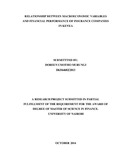| dc.description.abstract | The purpose of this study was to determine the relationship between macroeconomic variables and financial performance of Insurance Companies in Kenya. The financial performance measures of companies in Insurance industry used was the Return on Assets (ROA) which was regressed against the macroeconomic variables including real exchange rate (USD/Ksh), GDP growth rate, the change in money supply (M3), average annual lending interest rates as computed by CBK and inflation rate measured by annual percentage changes in the consumer price index (CPI) and other determinants of financial performance of Insurance companies included claim ratio, expense ratio and size of insurance companies as presented in published financial reports by Association of Kenya Insurers (AKI).
The study used descriptive correlation research design. The population of this study comprised of 46 Insurance firms listed in Kenya by the year 2013, according to AKI report 2013.The study employed annual secondary data which was obtained from the Central Bank of Kenya, Kenya National Bureau of Statistics and published annual financial statement from AKI reports. The period of study was five years from 2009 to 2013. The data was analyzed using descriptive analysis, correlation analysis and multiple regression analysis using SPSS.
This study found that Interest rate (0.027<0.05) Gross Domestic Product (0.031<0.05), Claim ratio (0.000<0.05) and Expense ratio (0.01<0.05) are statistically significant while Inflation rate (0.151>0.05), Exchange rate (0.169>0.05), Money Supply (0.696>0.05) and Size of the assets (0.412>0.05) with significance of more than 5% are not statistically significant. This reveals that x1, x5, x6 and x7 are suitable predictors of insurance company‟s financial performance.
The study recommends that in order for the Insurance companies in Kenya to improve, there is need for the Insurance Regulatory Authority (IRA) being the regulator of the industry to initiates policies measures that will help to manage the impact of exchange rate within the industry. Lower exchange rates would be more appropriate for companies in the Insurance industry in Kenya to perform better since they are negatively correlated with financial performance of these companies. The study also recommends that there is also need for the Government to control the broad money supply in Kenya as there is some evidence to suggest that higher money supply may lead to better performance of companies in the insurance industry in Kenya. This may be attributed to high disposable income by individual thus consuming services offered by Insurance companies. The study further recommends that there is need for the IRA to initiate policies that ensure lower inflation rate in the economy and create an insurance pool that will provide a low average lending interest rates which will improve the financial performance of companies in insurance industry as they are negatively correlated with each other. Lower interest rates will help improve the liquidity in the general sector and therefore lead to more investments and consumption. The results however clearly indicate that there are other variables that affect the financial performance of Insurance companies in Kenya this is due to the statistical insignificance between ROA and macroeconomic variables. The study therefore recommends the need for further studies on these variables, taking longer period into account. | en_US |

